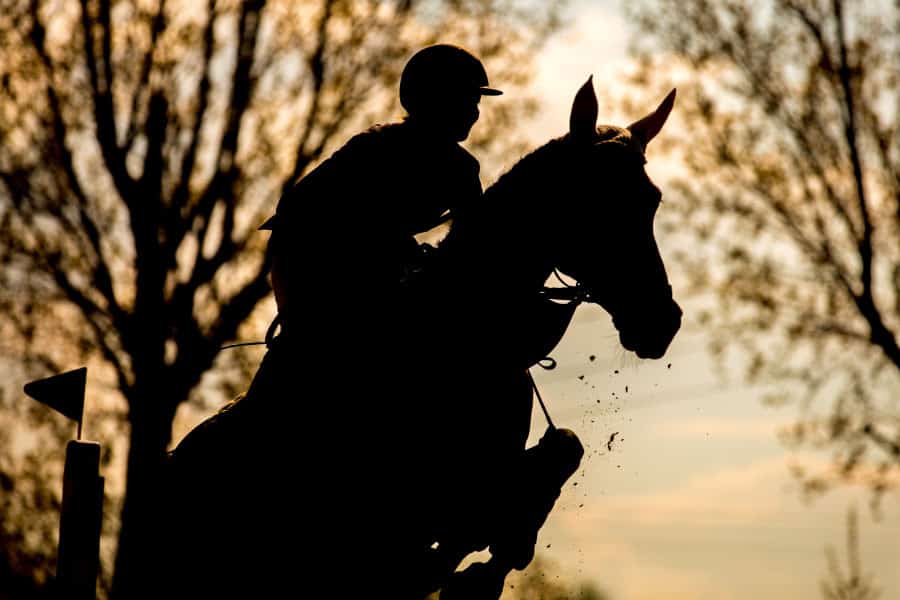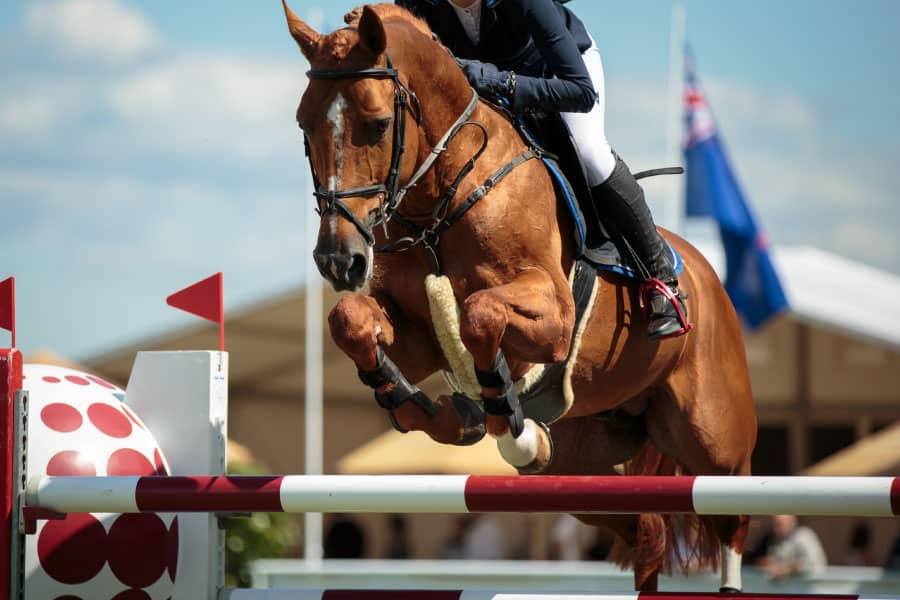- Your source for stall mats, rubber arena footing, arena harrows and arena dust control.

Have you ever heard that a horse only has a limited number of jumps in their lives? Some horses seem never to stop or give up, but sometimes, unfortunately, a horse’s jumping career is cut short due to injury, death, or something else.
There is no real set age that a horse should stop jumping as each horse is different. Not all horses jump, and some horses jump every second day. It all depends on the circumstances, the breeding of the horse, the maintenance of the horse, and the wear and tear of the jumping on the horse.
Older jumping horses are seen as great schoolmasters. These golden oldies tend to move to younger and less experienced riders to teach them the ropes of jumping at lower levels. Other older horses continue their career and still do well. But we need to ask ourselves, what is considered an old horse? How can we prolong their jumping career?
Common injuries in show jumping
The biggest reason why horses need to end their riding career is due to injury. Age does play a role, but if you have an older horse with fewer injuries, you can continue jumping them.
Here are some of the more common injuries in show jumping:
- Degenerative joint disease
- This is a common occurrence in an aging horse, especially in the showjumping and dressage ring.
- This is a normal occurrence where the joints’ synovial fluid is no longer sufficient to lubricate the joints, and the joint capsule and cartilage in the joints are worn down.
- Arthritic changes are also present. Bony changes occur in an attempt to fixate the joint to inhibit more damage to the joint capsule.
- It usually starts at the age of 12 and worsens with age.
- Spurs, ringbone, cysts, and other symptoms can occur.
- This disease cannot be stopped or healed. The process can be prolonged and made less painful with proper supplements, care, and cortisone injections into the joints.
- Diagnostics that can be used: X-rays, nerve blocks, ultrasound scans
- Suspensory ligament strains and tears
- The Suspensory ligament is an important ligament with a proximal and distal branch. It supports the fetlock and protects the fetlock from overextension.
- Suspensory ligaments get injured through excessive stress placed on the fetlock and onto the ligament; because this ligament is only slightly elastic, excessive stretching can cause sprains, strains, and tears.
- This type of injury is called a repetitive strain injury because it builds up over time and does not happen acutely.
- Diagnostics: Ultrasound scan
- Deep bone bruising
- The bone bruising referred to here mostly refers to bones in the hoof capsule and the lower legs.
- The coffin bone, navicular bone, coffin joint, navicular joint, and the fetlock joints in the front limbs are predisposed to bruising due to the amount of force on these bones in the landing phase of jumping.
- Bone bruising can also lead to abnormal bone growth and abscesses in the bone itself.
- Diagnostics that can be used: X-rays
- Navicular bone inflammation and inflamed navicular bursa
- The navicular bursa is small sacs that line the ligaments and tendons in the navicular joints.
- The navicular bone is a small bone inside the hoof capsule of the horse.
- Bruising of the navicular bone can happen due to hard impact on the hoof, such as jumping on hard surfaces.
- Inflammation is a response to injury to enable the body to protect the injured area and start the healing process. This can be caused by bruising, tearing, bursting, breaking, or cracking of the navicular bone inside the joint or to the associated ligaments and tendons.
- These types of injuries are very painful for the horse and are indicated by acute lameness and heat in the hoof.
- Diagnostics that can be used: X-rays, Ultrasound scans, Nerve blocks, Hoof testers
- Scar tissue formation
- Scar tissue forms from previous injuries such as tears, sprains, and lacerations
- Scar tissue can form inside muscle, tendons, and ligaments.
- Scar tissue is not as elastic as other normal soft tissues and thus can be the cause of re-injury or inhibit the horse in some way.
- Superficial scar tissue is not as big of a threat as deep tissue scarring.
- Scar tissue can not always be felt or seen on the horse. Thus a proper pre-purchase vetting is needed to pick up any abnormalities.
- Diagnostics that can be used: Ultrasound scans
- Muscle tears and bruising
- This can happen in many different ways.
- Bruising can be caused due to ill-fitting tack, especially on the back from a poorly fitted saddle.
- Muscles can tear due to insufficient warm-up and cool down. Thus when one enters the show ring, and the horse will start using their fast-twitch muscles, small tears can be caused due to the muscles not being warmed up properly.
- Showjumping can be very dangerous because of horse and rider injuries that can occur in the show ring and in the warm-up or at home. The horses can slip, trip, or stumble over the jumps, causing damage and bruising the muscles.
- Diagnostics that can be used: Palpating, Ultrasound Scans, CT scans
- These injuries are indicated by muscle stiffness, unwillingness to go forward, bucking, rearing, bolting, and tying up.

How to prevent injuries in show jumping horses
Good condition and health
First and foremost, it is very important to ensure that your horse is overall healthy and in good condition. Your horse needs to have the proper muscle tone to ensure that they are capable of doing the jumps and being fit enough to do a proper warm-up and a course of jumps.
Unfit horses are predisposed to injuries as they tire, and they can stumble, slip or injure their muscles due to overwork when they are not ready. Obesity in horses also causes a lot of problems as it is added weight to their joints, tendons, and ligaments. Obese horses are also predisposed to Equine Metabolic Syndrome and Laminitis.
Strengthening work for tissue adaptation
As mentioned before, the horse needs to be strong enough to keep up with the work. Exercising the horse frequently is very beneficial to both horse and rider. This will keep their fitness up, and their muscles adapt to the work.
Soft tissue adapts to exercise and work, which means that tendons will become stronger and a little bit more supple when they are correctly worked. Muscles build up and get stronger as well. Bone density has also been shown to increase at a young age when exposed to exercise.
Proprioception training
It is not fair to assume that a horse’s proprioception is always 100%, just like you need to train your eye when jumping a horse. The term “sure-footed” comes from horses with good proprioception and understanding of depth. Horses with better proprioception are better at hitting the correct take-off point, striding, and they tend to trip and stumble less.
To exercise this, the horse needs to be exposed to working on different footings and terrains at different speeds. Working in a sand arena only will make it difficult for your horse to be confident in a grass jumping arena, for example.
Correct warm up and cool down
The warm-up is probably the most important part, as a proper warm-up will ensure that the horse’s muscles are supple when they start working. This reduces the risk of stiffness and micro-tears in the muscle. Warming up allows for vasodilation, which increases the. Look flow to the muscles, which promotes the removal of lactic acid build up in the muscles. When a horse starts sweating, it can be used as an indication that the horse has been warmed up properly.
Give them a break
Giving your horse a break from work is a great way to improve their work and exercise outlook. Taking frequent hacks or breaking up your routine is a good way to keep your horse fit and in work while giving them a mental break. If you want to give your horse a proper time off when you are not doing shows, let them rest for a week or two and just turn them out into a large paddock.
Good quality and well fitting tack
A very important aspect of your riding is the proper fitting tack that is suited for you, your horse, and the discipline you are riding. An ill-fitting saddle can cause serious injury to your horse and hinder their athletic performance. It is best to get your saddle fitter out every 3 to 6 months because your horse is continuously changing size and shape as they work.
Good farriery
There’s a saying that goes, “no hoof, no horse” this means that if your horse has a problem with their hooves, it will affect them majorly. The hoof is the most important structure in the athletic horse as the horse needs to be pain-free to perform their best.
A good farrier will be able to balance the horse’s hooves and ensure that they stay sound for as long as possible. The hoof’s balance and the way it grows to affect the inner structures of the horse’s hoof and legs, especially the suspensory ligaments, deep digital flexor tendons, and the superficial flexor tendons. The small ligaments in the joints are also affected.
Maintenance of the horse
Physiotherapy and Chiropractic therapy in competition horses are very important to maintain overall healthy muscles. It prevents tension in the muscles, which can lead to compensation and other injuries.
Are you feeding the right supplements?
The supplements you feed play a vital part in your horses overall health.
Choosing the right supplement from a whole store full can be quite overwhelming, so let us look at the most important active ingredients your horse will need.
- Hyaluronic acid – joint lubrication
- Collagen – joint health, muscle health
- Vitamin A, B6, C, E – overall health
- Protein powder – promote muscle building
- Glucosamine – slows down the progression of Osteoarthritis and relieves joint pain.
- MSM – helps prevent cartilage degeneration
- Biotin and gelatin – promote hoof growth and promotes healthy coats
Conclusion
Caring and maintaining a happy, healthy athlete can be costly and hard work, but if you want to prolong your horse’s jumping career, you need to know your horse’s needs. The most important part is listening to your horse and providing your horse with the proper care that he needs.

